Understanding Shopify Variants vs Options: Key Differences Explained

Discover the key differences in Shopify variants vs. options to optimize your product listings and improve your store’s management and customer experience.
When running a Shopify store, understanding your product structure is essential. A common question is: What’s the difference between Shopify variants and options? Knowing how variants and options work helps you manage your products efficiently and improve customer experience.
This article breaks down what Shopify variants and options are, their benefits, implementation steps, and best management practices. We’ll also compare the two in detail so you can make informed decisions for your online store.
What are Shopify Variants?
Shopify variants represent the different versions of a single product. For example, a T-shirt in various sizes and colors each counts as a variant. Variants let customers choose specific product attributes on your product page. Each variant can have its own SKU, price, image, and inventory level.
Although Shopify allows up to 100 variants per product with three options, it is now rolling out support for up to 2000 variants per product through its newer product model. However, this expanded limit is currently available only to select stores using the GraphQL Admin API.
Variants exist because products often come in multiple forms or configurations. Managing variants helps you track inventory accurately and offer customers exactly what they want.
For example, a shoe might have variants for different sizes and colors, each tracked separately for stock management. Variants are created from product options, like size, color, or material.
Now that you understand what Shopify variants are, let’s explore the key benefits variants bring to your store.
Benefits of Shopify Variants
Shopify variants provide numerous advantages for both store owners and customers. They simplify inventory management and improve the shopping experience. Here are five benefits of using variants effectively.
- Improved Inventory Management
Variants enable precise tracking of stock levels for each version of a product. This prevents overselling and stockouts, which can harm your Shopify store’s reputation. By managing inventory at the variant level, you keep your sales and supply balanced.
- Better Customer Experience
Customers can select their preferred product version easily through variant selectors. This simplifies the buying process and reduces confusion on the product page. Clear variant options help shoppers make confident purchasing decisions.
- Flexible Pricing and SKUs
You can assign different prices and SKUs to each variant, tailoring costs to product differences. This flexibility helps you manage profit margins better and keeps your product catalog organized. Accurate SKUs support order fulfillment and reporting.
- Custom Images for Variants
Each variant can have a unique image, showcasing specific features like color or style. This visual clarity attracts customers and provides a more engaging shopping experience. Images linked to variants reduce returns caused by misunderstandings.
- Automated Order Fulfillment
Since variants correspond to specific product versions, packing and shipping become more accurate. Your warehouse team can easily identify which item to pick, reducing errors and returns. Effective fulfillment increases customer satisfaction and loyalty.
Having seen the benefits, let’s move on to how you can implement Shopify variants step by step.
Steps to Implement Shopify Variants
Implementing variants correctly helps your Shopify store function smoothly and provides a better customer experience. You need a clear, step-by-step process to add and maintain variants. The following steps will guide you through setting up product variants.
Step 1: Log in to Your Shopify Admin and Navigate to Products
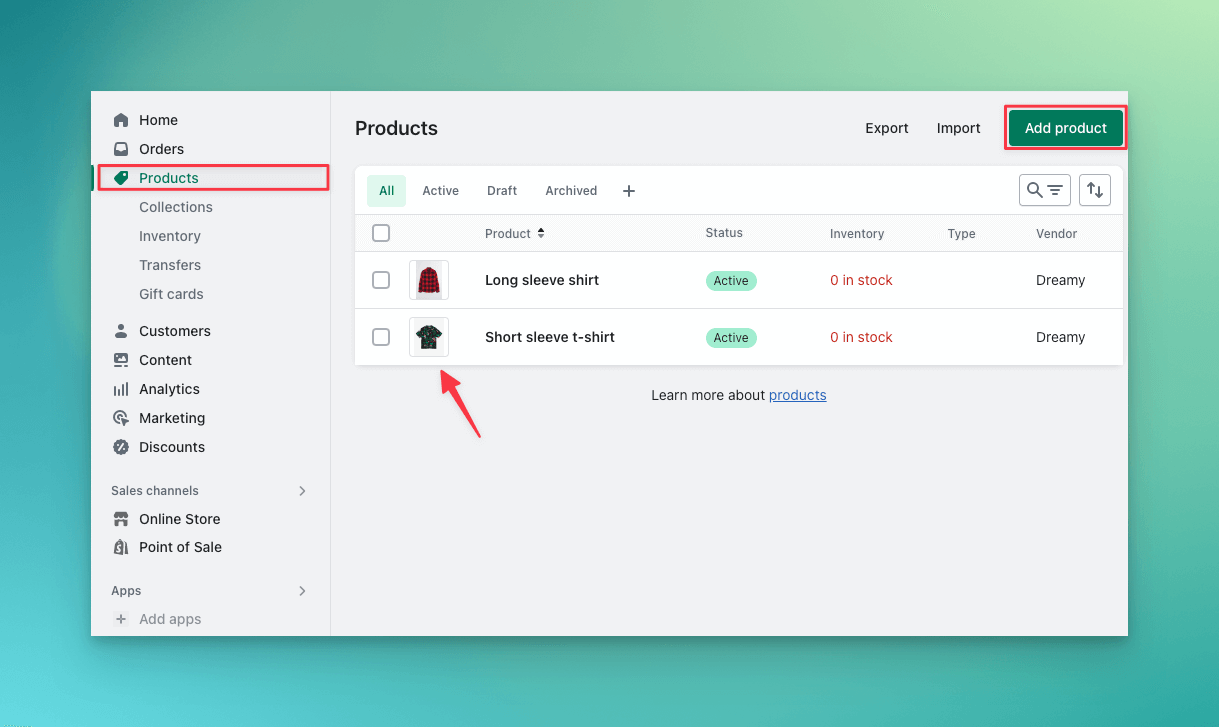
Start by signing in to your Shopify admin dashboard. Then, locate and click on the Products section, where all your items are listed. This is the central hub for managing product details and variants.
Step 2: Select or Create a Product for Variants
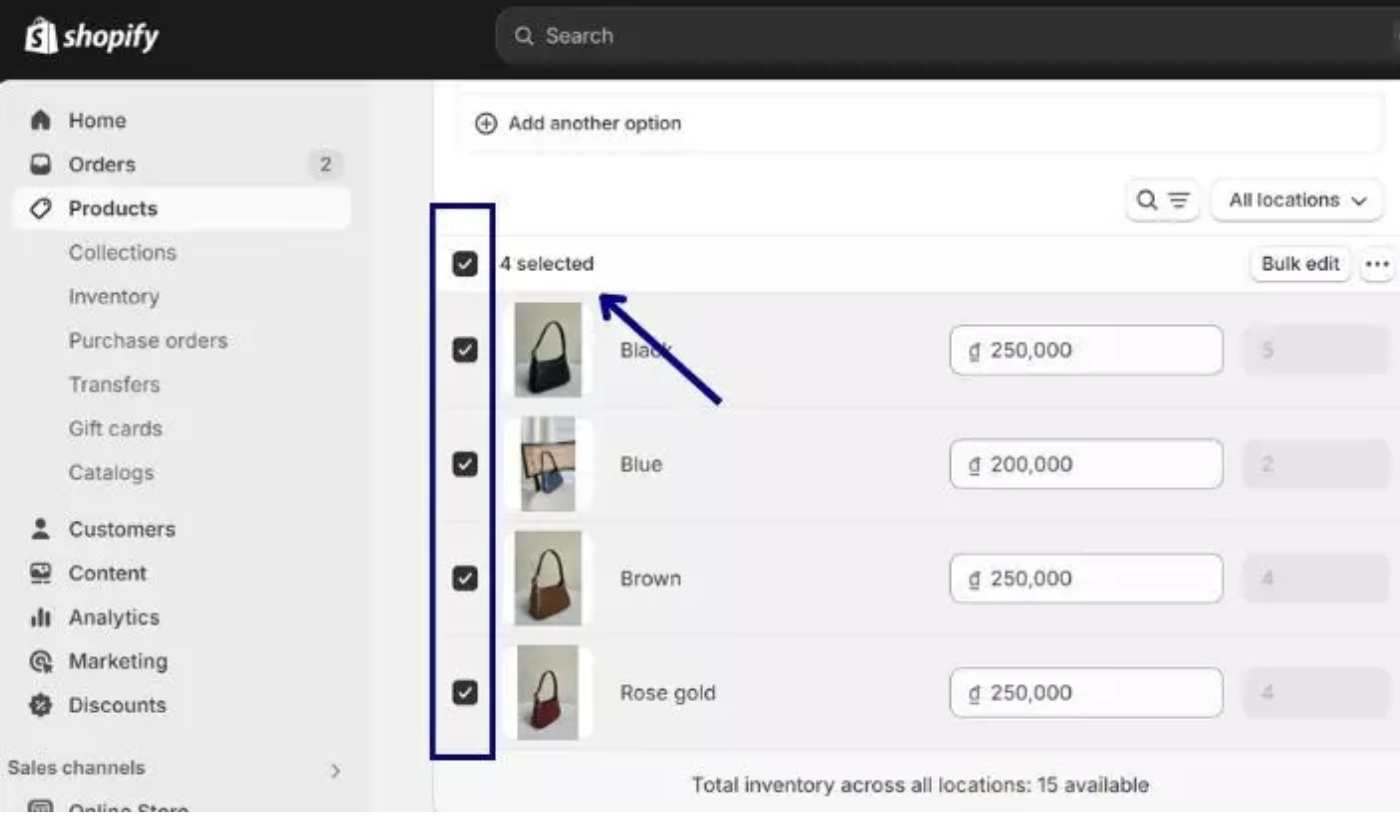
Choose an existing product to add variants to, or create a new product if necessary. This flexibility lets you manage current inventory or launch new items with multiple options. Click on the product to open its details.
Step 3: Scroll to the Options Section and Add Option Names
Within the product editor, scroll down to the Options area. Here, add option names such as “Size,” “Color” or “Material.” These labels represent the categories customers will choose from on the product page.
Step 4: Enter Values for Each Option
For each option, input the different values available. For example, sizes might be Small, Medium, and Large, while colors could be Red, Blue, and Green. These values form the basis for creating variants.
Step 5: Shopify Automatically Generates Variants
Once you enter all option values, Shopify generates every possible combination as a variant. This automatic generation saves time and makes sure that no option is missed.
To elevate this experience, consider using StarApps Studio’s SA Variants: Combined Listings, which splits variants and displays them as color swatches directly on collection pages. This feature provides variant-specific product titles, images, URLs, and descriptions, improving SEO, search filtering, and customer navigation.
Step 6: Edit Variant Details as Needed
You can then customize each variant’s price, SKU, weight, and images individually. This step is vital to reflect real product differences accurately. Properly editing variants helps with inventory and order fulfillment.
Step 7: Save Your Product to Apply Variants
Finally, save your changes to update the product with its new variants. These variants will now appear on your Shopify storefront for customers to select. Saving ensures your store data is current and functional.
With implementation clear, it’s time to explore best practices for managing your variants effectively.
Best Practices for Managing Variants
Managing variants well keeps your store organized and customer-friendly. Adopting best practices prevents confusion and errors. Here are five tips for effective variant management.
- Limit the Number of Variants
Too many variants per product can slow down your store and confuse customers. Shopify allows up to 100 variants, but consider limiting to essential options only. Combining variants keeps your store fast and user-friendly.
- Use Clear and Consistent Naming
Label variant options clearly, such as “Small” instead of “S.” Consistent naming helps both customers and your team identify variants easily. This practice reduces order mistakes and improves the user interface.
- Assign Unique SKUs
Give each variant a unique SKU for accurate inventory and order management. Unique SKUs prevent stock mix-ups and simplify sales tracking. Make sure that your team understands SKU assignments.
- Upload Distinct Images per Variant
Use variant-specific images to show the exact product version. This visual cue helps customers confirm their choice and lowers return rates. High-quality images improve overall store appeal.
- Regularly Update Inventory
Keep variant stock counts accurate to avoid overselling. Use Shopify’s inventory management tools or apps to automate stock updates. Proper inventory control builds customer trust.
Now that we’ve covered variants in detail, let’s shift focus to Shopify options and their role.
What are Shopify Options?
Shopify options are the product attributes or categories you define for your items. Options might include size, color, material, or style. They serve as the basis for creating variants. For example, the option “Size” could have values like Small, Medium, and Large.
Options themselves don’t track inventory or sales; they act as labels for your product variations. When you add options, Shopify uses them to generate variants by combining different option values. You can create up to three options per product, each with up to 100 values.
Options appear as dropdown menus, swatches, or buttons on product pages, allowing customers to choose how they want the product. Proper use of options makes browsing your Shopify store easier and more intuitive.
Having defined Shopify options, we’ll next discuss the key benefits they bring to your product management.
Benefits of Shopify Options
Options improve product customization and browsing on your Shopify store. They create intuitive menus that help customers find the right products quickly. Here are five key benefits of using Shopify options.
- Simplifies Product Customization
Options let customers easily select product features they want, such as color or size. This improves the shopping experience by making choices clear and straightforward. Clear options reduce buyer hesitation.
- Enables Variant Creation
Options form the basis for generating product variants automatically in Shopify. This saves time and avoids manual variant creation errors. It ensures your product catalog reflects all available versions.
- Improves Store Navigation
Options displayed as swatches or buttons help with visual browsing on your Shopify site. Customers quickly filter and compare products based on their preferences. Better navigation can increase conversion rates.
- Supports Limited Product Attributes
Shopify limits each product to three options, helping store owners focus on essential product differences. This keeps your product pages clean and prevents overwhelming customers. Focused options highlight your best-selling points.
- Flexible Display Formats
Options can be displayed in different formats like dropdowns, swatches, or radio buttons, depending on your theme and apps. This flexibility lets you customize the look and feel of your product pages. Attractive options improve engagement.
With benefits in mind, let’s walk through the steps to implement Shopify options properly.
Steps to Implement Shopify Options
Adding options to your Shopify products is straightforward but requires careful attention to detail. Proper setup helps customers navigate your store easily and variants are generated accurately. Follow these clear steps to implement Shopify options effectively.
Step 1: Open Your Shopify Admin and Navigate to Products
Log in to your Shopify admin dashboard and click on the Products section. This is where you can view, edit, and create product listings. It’s the starting point for managing your store’s options.
Step 2: Choose or Create a Product to Add Options
Select an existing product you want to add options to, or create a new product listing. This allows you to update the current inventory or launch new products with defined options. Open the product details page to begin.
Step 3: Scroll to the Options Area and Add Option Names
Within the product editor, scroll down to the Options section. Enter an option name such as “Material,” “Size,” or “Color” These options will appear as selectable attributes for customers on your product page.
Step 4: Enter Values for Each Option
For every option, input the possible values available to customers. Examples include “Cotton,” “Polyester,” and “Silk” for a fabric option. These values help generate product variants when combined.
Step 5: Repeat for Additional Options, Up to Three
Shopify allows up to three options per product. Add more option names and their values as needed, like “Size” with values Small, Medium, and Large. Limiting options keeps your product pages user-friendly and manageable.
Step 6: Save the Product to Generate Variants Automatically
Once you save your product, Shopify will automatically create all variant combinations based on the options you added. This automation saves time and reduces errors. You’ll now see all variants listed for management.
Step 7: Adjust Individual Variant Details as Needed
Customize each variant’s price, SKU, inventory, and images to reflect real differences. Accurate details ensure proper stock control and clear customer information. Regular updates keep your store data current.
Implementing Shopify options correctly structures your product catalog and simplifies variant management. For better functionality, StarApps Studio’s Variant Title King and Variant Alt Text King can automate variant titles and alt texts, improving SEO and user experience.
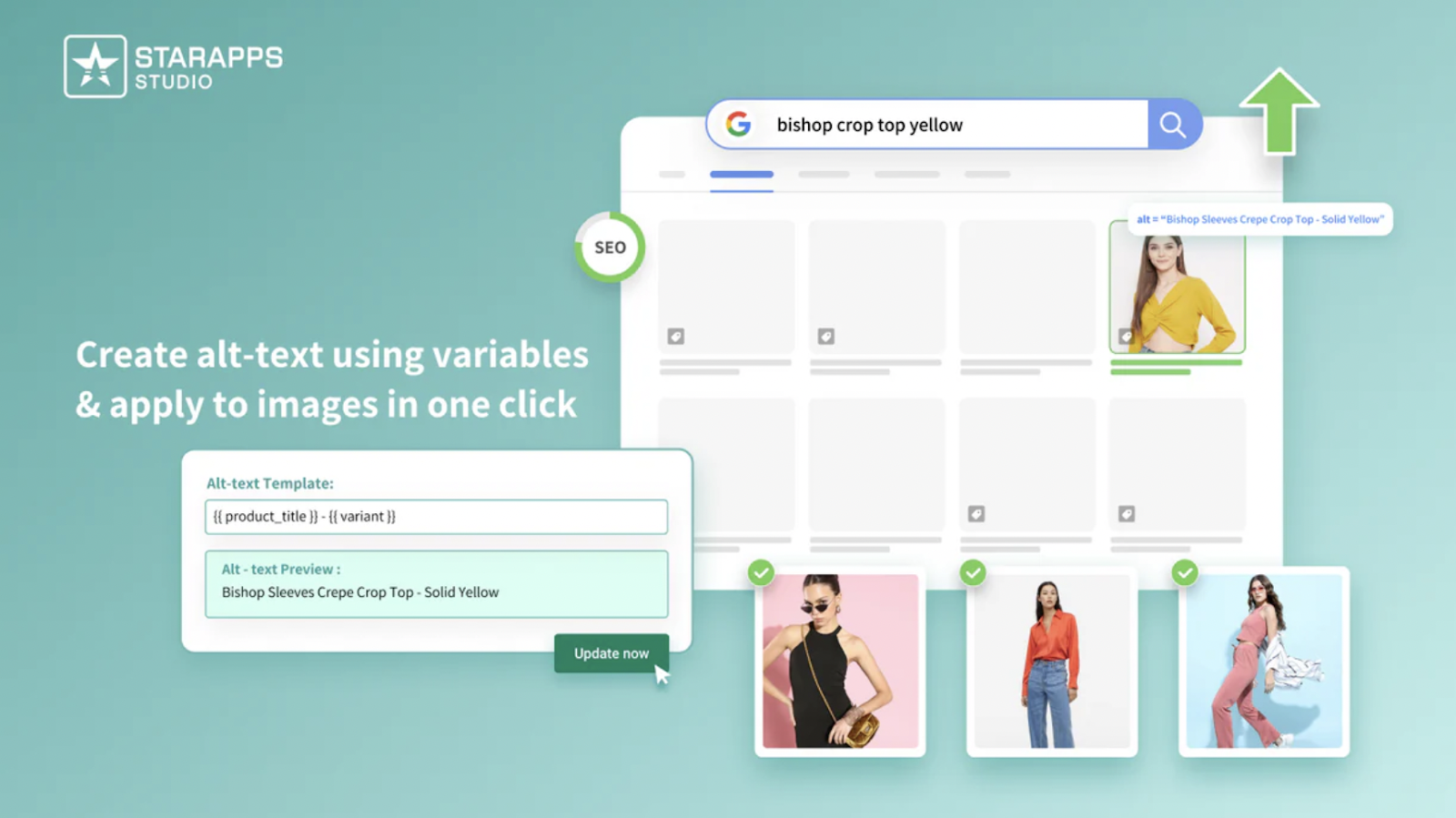
Once options are set up, applying best management practices will help maintain a streamlined store.
Best Practices for Managing Options
Effective management of product options leads to better user experience and inventory. Avoid common pitfalls by following best practices. This section shares five tips to manage your Shopify options smartly.
- Choose Relevant Options Only
Focus on the most important product attributes that impact buying decisions. Too many options confuse customers and clutter product pages. Prioritize options that improve user choice and store organization.
- Use Descriptive Option Names
Give options clear and meaningful names like “Fabric Type” or “Shoe Size.” Descriptive names make options easier to understand and select. This clarity adds to user satisfaction.
- Keep Option Values Consistent
Standardize how you list option values across products, such as “Red” not “red” or “R.” Consistency improves product filtering and search within your Shopify store. It also prevents errors in variant creation.
- Utilize Visual Swatches
Use color or pattern swatches where applicable to give customers a visual preview. Swatches make the selection process intuitive and engaging. They reduce guesswork, especially for color or texture options.
- Review Option Usage Regularly
Periodically audit your options to remove outdated or unused values. This keeps your store organized and user-friendly. Regular review helps you adapt to changing customer preferences.
Now that you know how variants and options work individually, let’s examine their differences.
Differences Between Shopify Variants and Shopify Options
Knowing the difference between Shopify variants and options helps you organize your store successfully. Each plays a unique role in managing products and improving customer experience. Here are ten key differences between Shopify variants and Shopify options.
Understanding these differences between variants and options helps you use both tools to their full potential. To further simplify variant and option management, we’ll explore how StarApps Studio can help.
Manage Shopify Variants and Options with StarApps Studio
Take full control of your Shopify store's variants and options with StarApps Studio’s suite of powerful apps. These tools transform how you display, manage, and optimize your product variants, driving sales, upgrading user experience, and improving SEO. Discover the features that make managing complex variants effortless.
SA Variants: Combined Listings

Enhance how your variants are displayed and discovered on collection pages. This app splits product variants into individual listings, making it easier for customers to find exactly what they need.
- Show all variants as color swatches on collection pages
- Group variants for smoother navigation and discovery
- Rich listings with unique titles, images, URLs, and descriptions
- Improve search and filter results with individual variant listings
- Quick comparison using color and image swatches

Streamline image management by automatically assigning multiple images to each variant. This keeps your galleries clean and displays only the relevant images for selected variants.
- Instantly display multiple variant images to boost conversions
- No manual tagging required; automatically assign images
- Integrates seamlessly with theme’s image gallery and zoom features
- Supports color swatches, 3D images, videos, and more
- Compatible with all themes and custom setups
Variant Title King: Color, SKU

Increase shopping confidence by updating product titles dynamically based on selected variants. This tool adds critical variant details to titles for better clarity.
- Add color names, SKUs, vendors, and variant details to titles
- Automatically update titles as variant options change
- Control title details easily via the app dashboard
- Works with all Shopify themes and top variant apps

Improve browsing speed and boost conversions with customizable swatches and variant selectors. Offer color, image, and size swatches directly on product and collection pages.
- Display color and image swatches, as well as variant pickers
- Add swatches to collection pages for seamless browsing
- Bulk upload color swatches and hide out-of-stock variants
- Integrates with Shopify Markets, B2B, and more
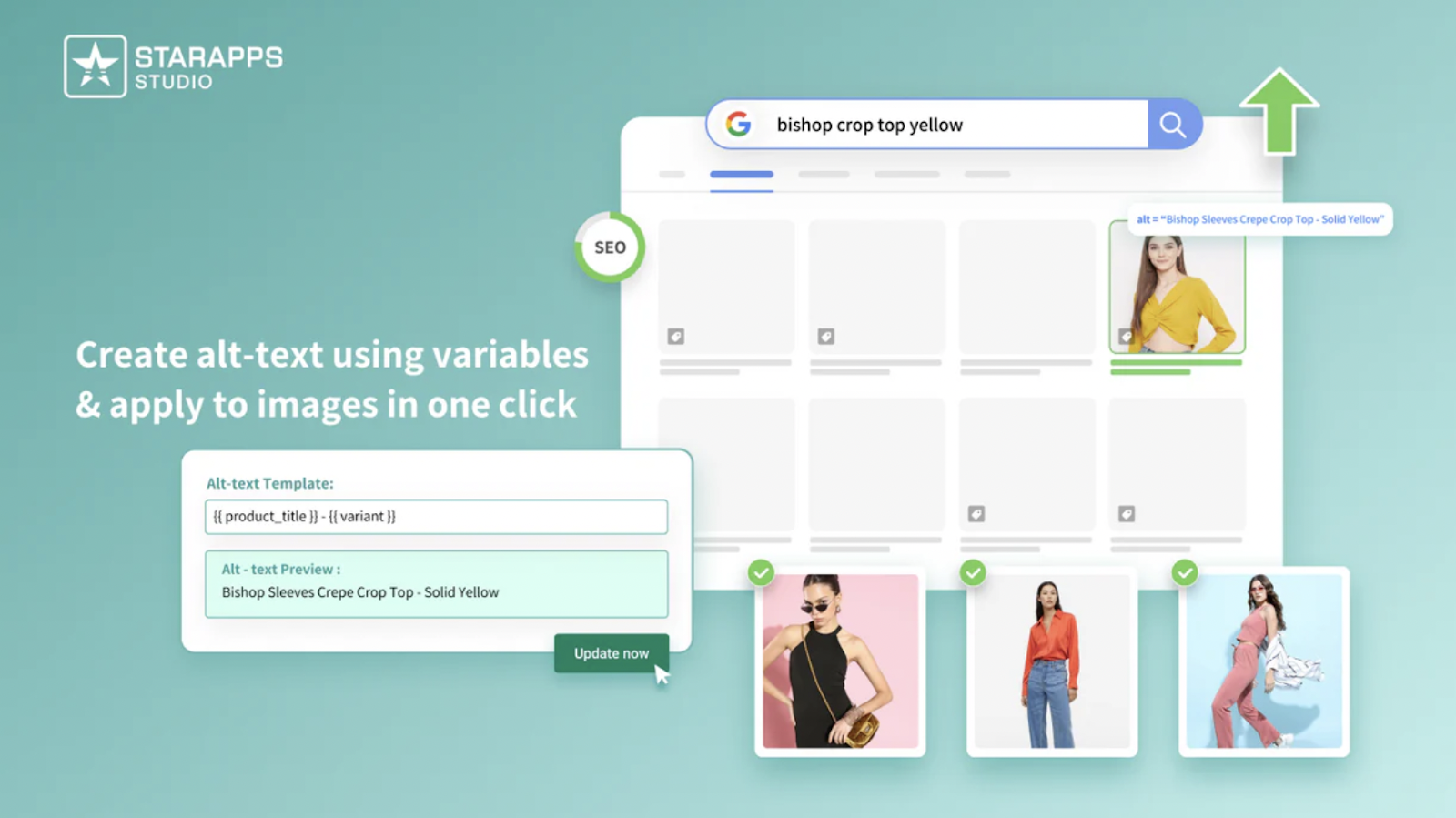
Automatically optimize alt texts for variant images to improve SEO and accessibility. This tool ensures your images are ADA and WCAG compliant while boosting search engine rankings.
- Add correct variant details to image alt texts for SEO
- Auto-sync alt texts with new product images daily
- Enhance image accessibility and improve Google image rankings
- Works with Variant Image Automator to ensure accurate alt text
Conclusion
Understanding Shopify variants vs. options is essential for effective product management in your Shopify store. Variants represent actual product versions with unique prices and inventory, while options define the attributes customers choose. Using both correctly enhances your store’s usability and SEO. Crafting clear variants and meaningful options makes shopping easier and improves conversions.
StarApps Studio offers powerful tools to transform your Shopify store by splitting variants into combined listings with color swatches and automating variant image assignments. This updates product titles with variant details like color and SKU, improving variant selection with swatches, and optimizing variant image alt texts for improved accessibility.
Contact us now to learn how StarApps Studio can optimize your variants and options effortlessly.
Heading
End-to-end traceability
To ensure regulatory compliance, you must have a complete overview of your products from production to shipping. Book a demo to see how Katana can give you full visibility of your operations.




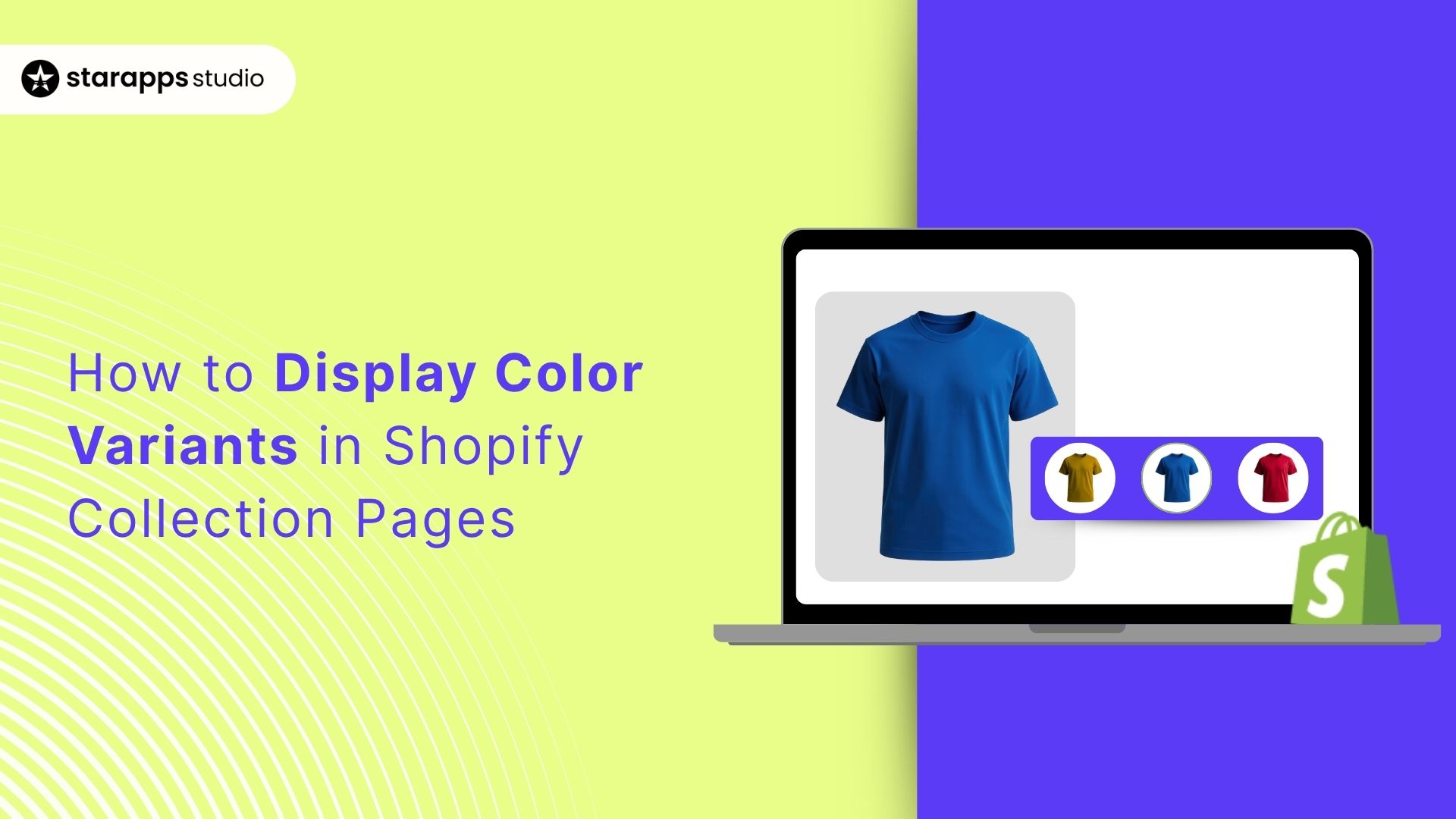
.png)
.png)